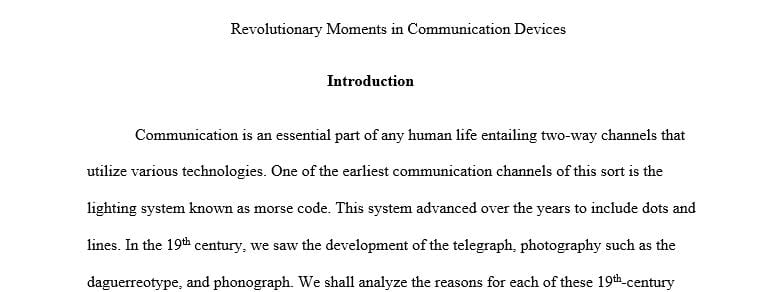Why were each of these nineteenth-century “new” media considered revolutionary at the time
While FaceTiming with a friend recently, you mention that you have been learning about nineteenth-century communication technologies in a “new media” class. Your friend, who is listening to Spotify while writing paper on her laptop and watching TikToks on her smartphone, looks confused. “What’s that old stuff have to do with anything new?” she asks, dismissively. Too busy to think about it at the time, but troubled by her response, you later reflect upon her question by composing an essay. (Yes, totally realistic scenario.)
In your essay, a response to your friend’s question – why study “old” media? – you will focus on the following three major nineteenth-century technologies: the telegraph, photography (including the daguerreotype), and the phonograph.
In composing your response, you should consider the following questions:
Why were each of these nineteenth-century “new” media considered revolutionary at the time? What did each technology do to set it apart from previous possibilities for transmitting, sharing, and/or storing information? Be specific!
How were these new media initially used? How, in some cases, did these uses differ from those intended or imagined by their inventors? How did consumers shape their use?
What impact, positive or negative, did each of these new media have on society and social relationships?
What parallels, if any, can be drawn between the uses of nineteenth-century new media and twenty-first-century new media?
How can a comparative study of nineteenth-century new media inform our understanding of the cultural reception and social effects (both positive and negative) of twenty-first-century new media?
Your essay should incorporate insights and ideas from all five of the following course readings:
Tom Standage, “The Thrill Electric,”
Katherine Stubbs, “Telegraphy’s Corporeal Fictions,”
Donald D. Keyes, “The Daugerreotype’s Popularity in America,”
Lisa Gitelman, “New Media Publics,”
John Philip Sousa, “The Menace of Mechanical Music,”
Your essay should be 1250 words – approximately 5-6 pages, double-spaced in 10- or 12-point font with one-inch margins. Attention to writing, spelling, and grammar constitutes part of your grade.
When citing references to the course readings above, be sure to include page numbers and to maintain a consistent style. Here are some examples:
Citing an author’s unique ideas or specific facts:
According to Smith, the technology was never used exactly as the inventor intended (14).
By 1900 the technology was available in 20 cities and more than 3 million homes (Smith 17).
[NOTE: When referring to the author by name in your sentence, you should cite only the page number on which the cited information appears. If the author’s name is not mentioned in the sentence, then cite the author’s last name and page number.]
Citing a direct quotation:
As Smith writes, “this technology was slow to be adopted due to several key factors” (18).
Since your essay will refer to texts that appear on the syllabus, you do not need to include a bibliography.
keyes_dageurreotype_s_popularity
sousa_menace_of_mechanical_music
_gitelman_new_media_publics_edit
stubbs_telegraphys_corporeal_fictions
standage_thrill_electric_victorian_internet
Answer preview to why were each of these nineteenth-century “new” media considered revolutionary at the time
APA
1635 words



